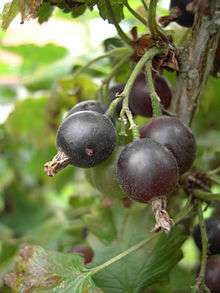Jostaberry
| Jostaberry | |
|---|---|
 | |
| Scientific classification | |
| Kingdom: | Plantae |
| (unranked): | Angiosperms |
| (unranked): | Eudicots |
| (unranked): | Core eudicots |
| Order: | Saxifragales |
| Family: | Grossulariaceae |
| Genus: | Ribes |
| Species: | R. ×nidigrolaria |
| Binomial name | |
| Ribes ×nidigrolaria Rud. Bauer & A. Bauer | |

The jostaberry is a complex-cross fruit bush in the Ribes genus, involving three original species, the black currant R. nigrum, the North American coastal black gooseberry R. divaricatum, and the European gooseberry R. uva-crispa.[1] It is similar to Ribes × culverwellii, the Jochelbeere, which is descended from just two of these species, R. nigrum and R. uva-crispa.[2]
Description
The cultivated plants are tetraploid.[3] They are descended from two separate first-generation crosses, both of which produced very few fruit.[4] Fertile tetraploids were produced using colchicine.[4] The name Jostaberry was created via combining the German words for blackcurrant and gooseberry, namely Johannisbeere ("Jo") and Stachelbeere ("Sta"). Following German pronunciation of "J", it may be pronounced "yostaberry" in English. The first cultivar was made available to the public in 1977. A number of varieties have been developed since then by various developers.
The nearly black berry, which is smaller than a gooseberry and a bit larger than a blackcurrant, is edible both raw and cooked. It is described as having a taste intermediate between a gooseberry and a blackcurrant, with the gooseberry flavor more dominant in the unripe fruit, and the blackcurrant notes developing as the fruit ripens. The ripe fruit will hang on the bush in good condition through late summer, but is very popular with birds. The somewhat unripe fruit can be used in cooking recipes as a gooseberry. Like blackcurrants the fruit freezes well, and like many other members of the Ribes genus it is rich in Vitamin C.
Commercial production of jostaberries is limited because they are not well suited to mechanical harvesting.[4] Compared to most other fruits, harvesting jostaberries is relatively labor-intensive per kilogram. Although harder to pluck than blackcurrants, the plant is thornless.
The plant itself grows to a maximum height of about 2 m, flowering in mid-spring, with fruit setting and ripening on a similar timetable to the blackcurrant. The plant displays hybrid vigor, growing and fruiting well and being resistant to a number of common diseases afflicting other Ribes. In particular the plant is resistant to American gooseberry mildew, blackcurrant leaf spot, white pine blister rust, and big bud gall mite. Flowers are hermaphrodite and the plant is self-fertile following insect pollination. Propagation is usually by cuttings, rather than by seeds.
References
- ↑ "Ribes ×nidigrolaria". USDA GRIN taxonomy.
- ↑ "Ribes ×culverwellii". USDA GRIN taxonomy.
- ↑ Büttner, R.; Hanelt, P.; Kilian, R.; Kilian, W. (2001). Mansfeld's encyclopedia of agricultural and horticultural crops: (except ornamentals).. Algae, Fungi, Pteridophyta, Gymnospermae, Angiospermae - Dicotyledones: Magnoliaceae - Chrysobalanaceae. Springer. ISBN 978-3-540-41017-1.
- 1 2 3 Anneliese Bauer (1985). "New results of breeding Ribes nidigrolaria: amphidiploid species hybrids between blackcurrant and gooseberry". ISHS Acta Horticulturae.
External links
| Wikimedia Commons has media related to Ribes nidrigolaria. |
- Plants For A Future database report: Ribes x culverwellii
- PracticallyEdible.com: Jostaberries
- National Gardening Association: Jostaberry
- GrowYourOwn.info: Jostaberry